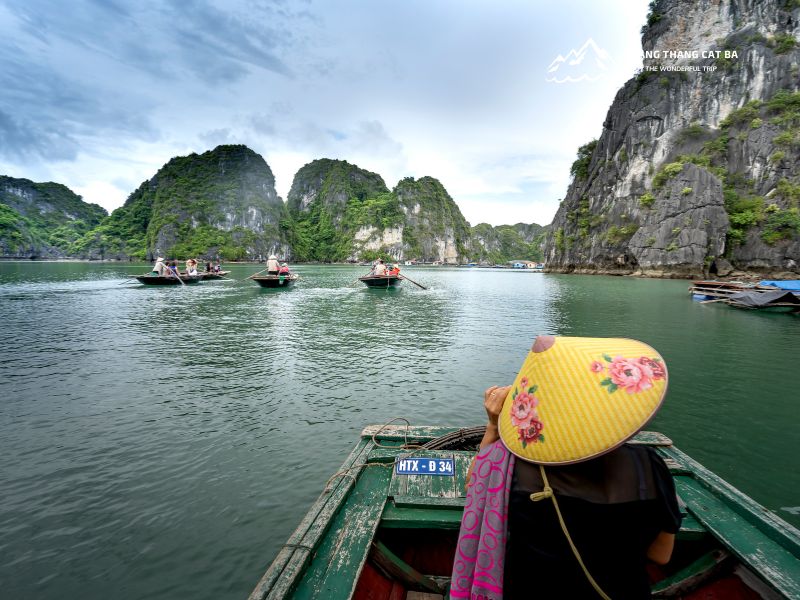How deep is Lan Ha Bay? Beneath its emerald ripples lies a world that balances safe shallows for families with secret channels that lure curious eco-travelers deeper. In this guide, we dive into Lan Ha Bay’s true depths — from calm 5–10 meter coves ideal for paddling to hidden pockets reaching 30 meters that shelter coral gardens and gentle currents. Whether you dream of a quick weekend swim, a safe family kayak, or a mindful snorkeling adventure, here’s how to explore Lan Ha’s underwater world responsibly — and when to go for the clearest views.
How Deep is Lan Ha Bay, Really?
Lan Ha Bay likely shares Ha Long Bay’s average depth of 5–10 meters (16–30 feet), with some deeper channels reaching up to 30 meters (98 feet) thanks to its karst geology and tidal action. This sheltered bay’s unique limestone towers and undercut caves hide submerged valleys and tidal lagoons that shift daily with a ~3-meter (10-foot) tide swing.
.jpg)
When the tide is high, local guides recommend exploring hidden caves and trying deep-water soloing — just be mindful, because low tide can quickly expose sharp rock shelves and shallow sandbanks. Compared to bustling Ha Long, Lan Ha’s quieter coves and active tidal erosion preserve more pristine shallows, making it safer for family-friendly kayaking and swimming. If you’re after the clearest depths for snorkeling or photos, plan your visit during calm daylight high tides for the best underwater views.
Does the Depth Affect Your Activities?
Yes — the depth of Lan Ha Bay directly shapes which water activities are safe and enjoyable for you. With depths ranging from 5–15m on average and up to 70m in channels, shallow zones near Ba Trai Dao Beach are perfect for families with kids — calm slopes, clear water, and safe swimming make it ideal for beginners.

Deeper areas like Ao Ech or Tra Bau (5–29m) invite confident swimmers and divers, but stronger currents mean you should never explore alone — always stay within 500m of your guide boat. Technical divers can explore depths beyond 30m near Cat Ba Island, but only with certified operators due to unpredictable currents.
Practical Tip: Always check for seasonal conditions — October to November offers calm seas and great visibility, while typhoon months (June–August) make kayaking and swimming unsafe. And remember: Kayaking is suspended in Lan Ha Bay as of November 2024, so plan guided tours and shallow swimming instead.
Lan Ha Bay vs. Ha Long Bay (Depth & Experience)
|
Factor |
Ha Long Bay |
Lan Ha Bay |
|
Average Depth |
5–10 meters (16–33 feet); deeper channels reach 15–29 meters (49–95 feet) |
Shares the same geological formation as Ha Long Bay — comparable depth range |
|
Visitor Density |
High crowding (thousands daily); iconic but busy |
Lower visitor numbers; offers peaceful escapes |
|
Water Clarity |
Can be impacted by pollution and heavy cruise traffic |
Notable for clearer, pristine waters |
|
Main Activities |
Large cruises, cave tours |
Kayaking through narrow caves (e.g., Dark & Bright Cave), snorkeling vibrant coral areas |
|
Ecosystem Health |
Pollution challenges despite clean-up efforts (e.g., “Clean the Bay” and Jokaso tech) |
Strong conservation focus, coral restoration, plastic-free tourism, monthly bay clean-ups |
|
Safety for Travelers |
Crowding can delay emergency response and reduce swimming water quality |
Lower density improves safety and water enjoyment |
|
Environmental Impact |
Deep channels support large ships but raise pollution risk |
Regulated access protects delicate shallows, supporting robust biodiversity |
|
Traveler Feedback |
Iconic scenery; concerns about environmental strain; structured tours |
High traveler satisfaction; immersive activities in unspoiled areas; praised for sustainable tourism practices |
|
Expert Insights |
Waste management improving, but sustainability remains a key challenge |
Viewed as a leading model for eco-friendly bay tourism |
|
Recommendation |
Ideal for first-time visitors wanting iconic sites and large cruises |
Better for travelers craving authentic nature, calm waters, and hands-on conservation experiences |
In summary, both bays share similar depth profiles, but Lan Ha Bay provides clearer waters, richer biodiversity, and more sustainable travel experiences, making it a standout for eco-conscious adventurers and families seeking safe, unique water activities.
Travel tips: Boating, swimming & diving in Lan Ha Bay
To enjoy Lan Ha Bay’s safe waters (average depth 5–10m) responsibly, choose trusted eco-operators for kayaking, swimming, diving, and rock climbing.

Kayaking & Swimming:
Glide through shallow lagoons near Viet Hai Village and Bai Trai Dao beaches—depths stay around 5–10m, perfect for families. Always swim within 500m of your boat, wear a life vest, and stick to “Grade A” zones. Hanoi Eco Tour runs small-group trips that directly support local communities.
Diving & Snorkeling:
Explore vibrant coral at Lan Ha Bay (5–30m) or deeper caves at Cong Do Island (15–29m). Spot reef sharks and tropical fish but never touch marine life. Use only eco-certified guides like Lyra Cruises, known for plastic-free tours and bay cleanups.
Deep Water Soloing (Rock Climbing):
Try climbing over crystal waters on routes from 5a–7b+ in secluded lagoons—best between September and November. Always climb with licensed guides, and avoid unmarked cliffs.
Stay Eco-Safe:
Wear reef-safe sunscreen, bring refillable bottles, and check daily water grades.
From gentle shallows perfect for first-time swimmers to deeper coral hideaways for curious snorkelers, Lan Ha Bay’s depths invite every traveler to find their own balance of adventure and safety. Quang Thang Cat Ba’s eco-focused tours offer you a secure, sustainable way to discover this hidden side of Vietnam’s coast. Embrace the calm, trust the guides, and carry home a story worth sharing.

